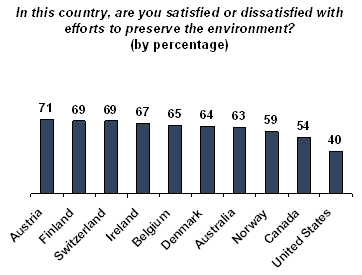GALLUP NEWS SERVICE
PRINCETON, NJ -- Founded by the late Wisconsin Sen. Gaylord Nelson, the first Earth Day took place on April 22, 1970 with the intent to raise awareness of the damage being inflicted upon the Earth and to demonstrate the growing support for legislative action. With more than 20 million people participating in rallies across the United States, Earth Day made a huge impact and has been credited with leading to the passage of many crucial pieces of environmental protection legislation including amendments and extensions of the Clean Air Act, the Clean Water Act, and the Endangered Species Act. Since 1970, the holiday has become truly global, spreading to 175 countries and uniting more than 500 million people annually.
The Gallup World Poll asked the people of more than 130 countries, including the United States, for their perceptions about the state of the environment where they live. In each country, respondents were asked the same three questions: 1) their satisfaction with the quality of the air in their community, 2) their satisfaction with the quality of water in their community, and 3) their satisfaction with efforts to preserve the environment at the national level.
The U.S. results were measured in a April 13-15, 2007, Gallup Poll and show that 85% of Americans are satisfied with the quality of air where they live and 77% are satisfied with the quality of water -- but only 40% are satisfied with efforts to preserve the environment in the country, while 58% are dissatisfied.
Americans' views on the environment are perhaps most appropriately compared to those in other countries with high per-capita gross domestic products (at purchasing price parity). These are the countries with the most productive economies in the world relative to their population size. Besides the United States, the top-10 list includes several wealthy European countries, Australia, and Canada.
On air quality, the United States falls in the middle of this list of countries. At least 71% of respondents in all countries are satisfied with quality of air where they live. The lowest levels of satisfaction are found in Belgium (71%) and Canada (77%). Two countries located in the northern region of Europe -- Ireland and Denmark -- top the list with 94% satisfaction.

Satisfaction with local water quality among the other countries with high per-capita GDP is significantly greater than in the United States. In fact, the U.S. satisfaction level of 77% is eight percentage points lower than that in any of the other countries analyzed. Belgium is the lowest-rated country outside the United States, while Denmark is the highest.

Efforts to improve the environment get the worst ratings among all the countries examined. The highest proportion of the population satisfied with efforts to care for the environment is only 71%, in Austria. For the most part, of all the high per-capita GDP populations on the list, those in Europe are the most satisfied with the efforts made at the national level to protect the environment. Canadians, at 54%, are considerably less likely to say they are satisfied than any European population. But the lowest level of contentment by far is seen among Americans, less than half of whom say they are satisfied with efforts to preserve the environment.

Survey Methods
Results for the U.S. are based on telephone interviews with approximately 1,000 national adults, aged 18 and older, conducted April 13-15, 2007. For results based on the total sample of national adults, one can say with 95% confidence that the maximum margin of sampling error is ±3 percentage points.
In all other countries, results are based on telephone interviews with approximately 1,000 adult residents (with the exception of Canada, where 1,355 interviews were conducted). Non-U.S. surveys were conducted in 2005 (for Belgium, Denmark, and Australia) and 2006 (for all others). For results based on these samples, one can say with 95% confidence that the maximum margin of sampling error is ±3 percentage points.
In addition to sampling error, question wording and practical difficulties in conducting surveys can introduce error or bias into the findings of public opinion polls.
